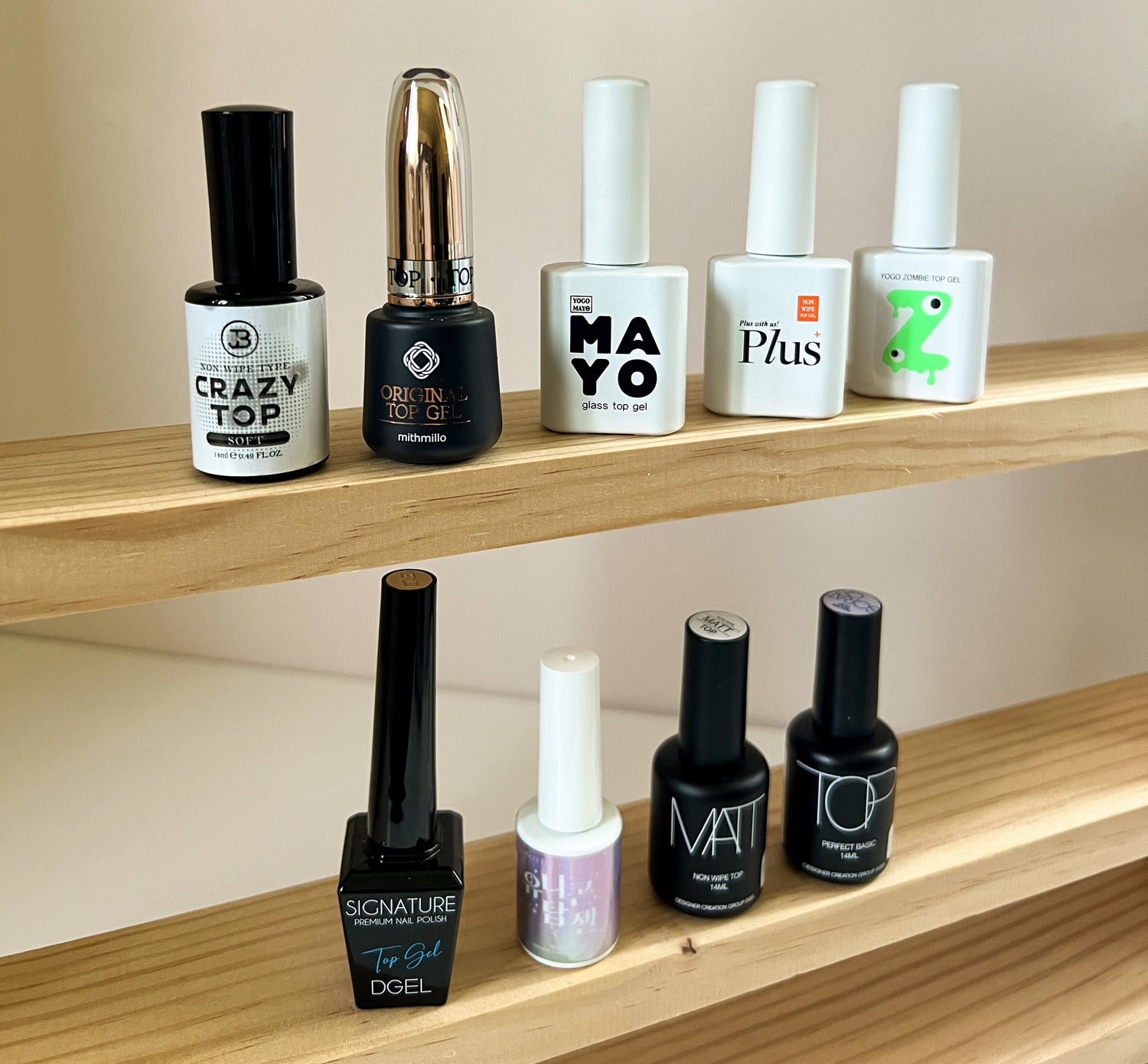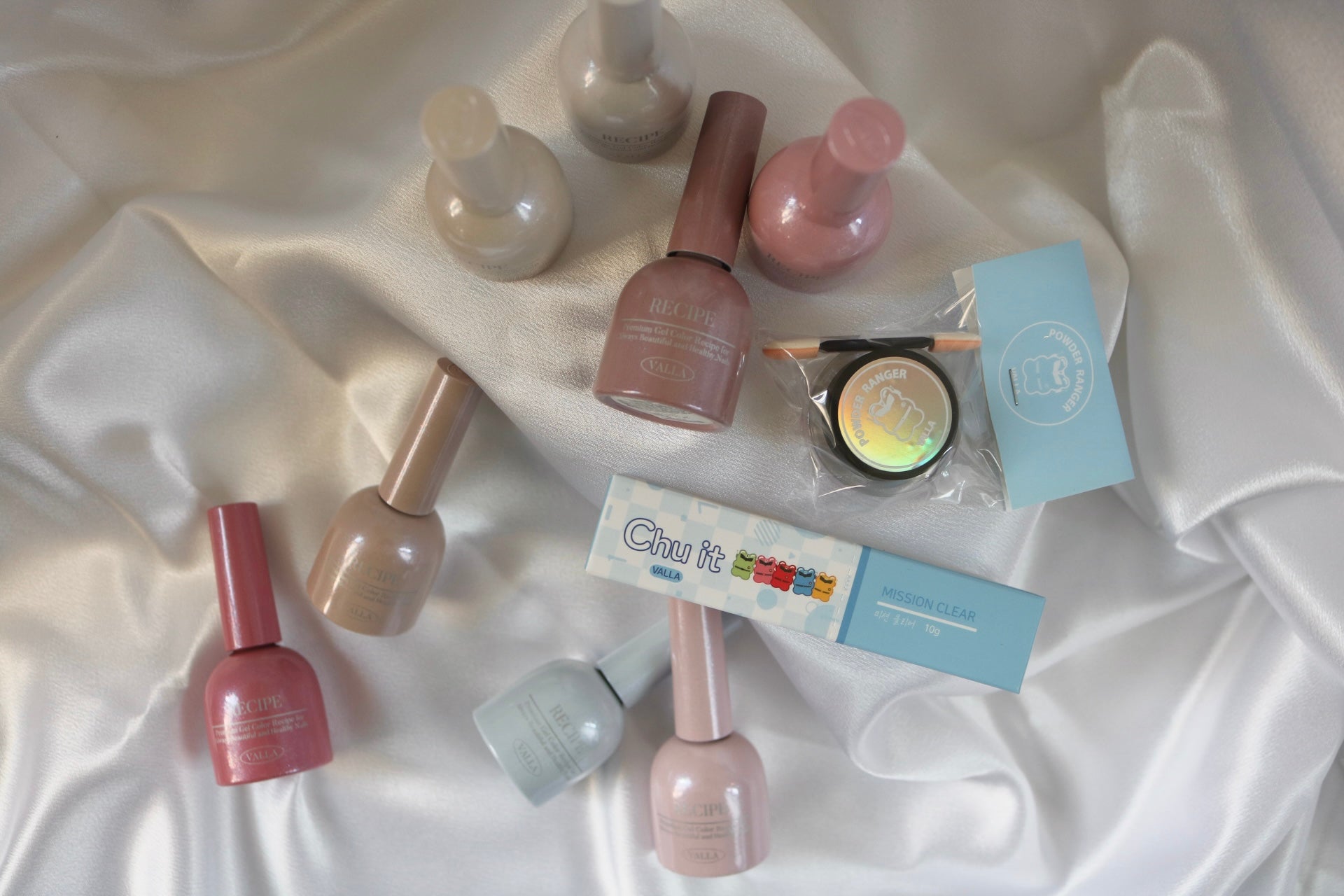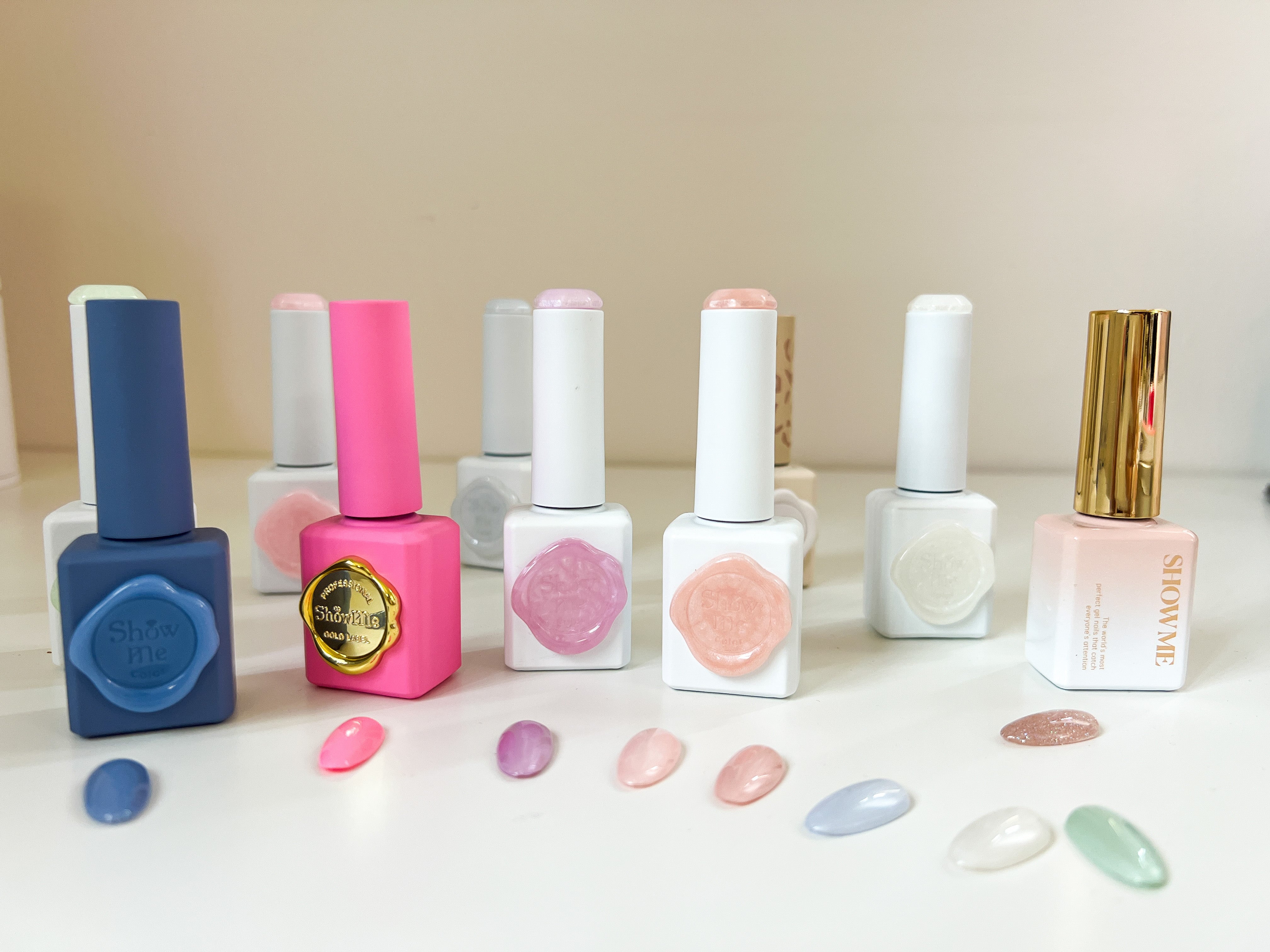
There are so many top gels on the market! At Sweetie Nail Supply, we offer over fifty options of top gel products. How do you know which top gel to choose? Which top gel is the best? If these questions have crossed your mind, read on as we break down the basics of top gels to help you decide what you need.
When it comes to doing nails, top gel is the final step to application as it seals in and protects color and design to help your manicure last. As a general and basic guideline, it is ideal to use a top gel that is the same brand or created in the same gel polish line as the gel color you are using for your manicure. Base gels, color gels, and top gels within the same line or brand are typically created to work as a system with formulas that are designed to be most compatible for optimal results. Some top gels may also work well with other gel color brands. However, the compatibility, qualities, and desired results are not always guaranteed and may require your own testing trials to determine its performance in usage across the different gel color brands you may have. It is always best to follow the product manufacturer’s instructions for safe and optimal results.
You may notice that even within the same brand, there might be several options of top gels to choose from. It can be overwhelming to determine which ones you need. Here are a few properties that are helpful to better understand the differences in top gels. Understanding these properties can help you identify which top gels offer features that are best suited for you or your client’s needs.

Finish Type
Glossy
Top gels with a glossy finish are the most common type of top gels. A glossy finish can add a more luxurious and eye-catching look to a finished manicure. Glossy top coats provide a protective layer with high shine and reflection, offering a sleek overall appearance. The glossy finish bounces off light, making colors appear brighter and more vivid. Glossy top gels are generally more durable and resistant to general staining. Although durable, any scratches and scuffs may be more noticeable as they dull the glossy protective top coat.
Matte
Matte top gels offer a smooth and velvety texture. Matte top gels offer a sophisticated, modern, or minimalistic appearance. Matte finishes do not reflect light, enhancing the depth and richness of color, making it appear more vibrant and saturated. Although matte finishes are less likely to show smudges, it can be more prone to general staining. Scratches and scuffs may not be as noticeable on matte as they are typically concealed by the non-glossy surface.
Other
Other top coats can offer a glossy or matte finish with glitter or other small particles for a fun finish that eliminates the extra step of applying glitter gel before top gel. These types of top gels are great for adding a little extra touch of distinction and personality without costing you extra time.

Wipe Vs. Non-wipe
Wipe
Traditional top gels can leave a tacky or sticky layer after curing, known as the inhibition layer. The inhibition layer forms naturally when gel is exposed to oxygen during the curing process. As gels cure under a nail lamp, small molecular chains link together to form longer chains, creating a hardened finish. However, exposure to oxygen blocks the ends of the forming polymer chains from becoming longer, causing a semi-hardened and tacky surface. Since the gel beneath this layer is shielded from oxygen, the polymer chains can fully form and harden the gel. The inhibition layer requires removal using an alcohol or cleansing wipe to reveal the hardened gel underneath that will offer the sealing and glossy benefits of a finished top coat.
Non-wipe
Top gels that are non-wipe do not leave a tacky or sticky layer after curing. Non-wipe top gels are generally formulated with ingredients to maximize polymerization during curing, leaving a hardened and shiny finish immediately afterwards. Since non-wipe gels do not leave a tacky finish, a cleansing wipe is not required. Hence the term “non-wipe.” However, it is still a good idea to wipe the nails with a final cleanse to remove any uncured gel that may not be noticeable. Non-wipe top gels are also versatile as they can be used for applying powders and other nail art processes.
Viscosity
When it comes to gels, viscosity is the measure of a fluid’s resistance to flow and indicates the thickness in consistency. It is important to understand viscosity to know which top gel to reach for that will achieve the results you need.
Low
Gels with a low viscosity flow easily and is generally thinner in consistency. Low viscosity gels self-level quickly without much effort. They are ideal for applying in thin layers to achieve a more natural look or for use when applying multiple layers of gel. A low viscosity top gel will typically be easiest to apply and use, ideal for beginners or in the salon setting for quick top coat application, providing a finished and sealing layer on a manicure.
Medium
Gels with a medium viscosity have a slightly thicker consistency, leading to a slower flow and moderate self-leveling. Medium viscosity gels are versatile, as they can be used for overlaying color, encapsulating designs or glitter, while slightly shaping and building the nail, providing more durability and protection. Their consistency offers excellent control, allowing for detailed work without the gel running to minimize product flooding the cuticles and maintaining the desired shape.
High
Gels with a high viscosity have a dense and heavy texture, making them less fluid and more challenging to spread compared to lower viscosity gels. Thick viscosity gels have minimal flow and do not run or spread easily, allowing for precise application and maneuvering. These gels hold their shape well, which is ideal for applications that require structure or build-up. High viscosity top gels are great for providing hard durability and strong protection, especially for medium to long nails. They can also be used for building 3D details on the nails. High viscosity gels offer strong durability and capability for detailed nail art, making them a preferred choice for complex applications and structural work.

Other Features
Non-yellowing
Sometimes when the chemicals in some clear or top gels are exposed to oxygen during the curing process, it can cause yellowing, resulting in unwanted discoloration. Gels that have a non-yellowing feature do not have this yellow discoloration occurrence, resulting in a clear protective finish that reveals true color underneath.
Non-heating
When gels cure in a nail lamp, longer molecular chains form in an exothermic reaction to harden the gel, which can sometimes cause heat spikes under certain conditions such as thin nails, a lot of gel being cured (such as in a gel overlay), or too strong of a nail lamp power. Gels that offer non-heating benefits have a specially formulated gel that minimizes this heat spike occurrence.
Non-shrinking
Gels that indicate non-shrinking benefits offer a more stable finish, maintaining its size and shape after curing to ensure that the finished gel appearance remains consistent without any noticeable reduction in volume or coverage. Non-shrinking gels help to achieve a smooth and even surface as there is no contraction of the gel that can lead to uneven spots or gaps. These gels also avoid common issues like wrinkling or uneven edges. Non-shrinking gels provide a more reliable and durable finish, as the gel remains firmly in place without any risk of pulling away from the edges and maintains the intended appearance, reducing the need for reapplication due to shrinkage.
HEMA-free
Top gels that are HEMA-free do not contain the monomer known as Hydroxyethyl Methacrylate which is commonly used in gel and other nail products to contribute to the flexibility, durability, and adhesion properties of the product. When exposed to HEMA for prolonged periods of time or repeatedly, it can potentially lead to allergic reactions or sensitivities in some individuals. HEMA-free products are formulated with HEMA alternative ingredients to minimize the risk of allergic reactions.
If you are a DIYer who prefers simple manicures for a clean and minimal look, most likely you won’t need more than two or three types of top gels. If you are a nail art enthusiast or nail service provider, it is likely that you will require the use of multiple kinds of top gels. Knowing the common manicure needs of you or your clients, what features various top gels offer, and understanding the various properties of top gels can help you identify which top gels will be optimal choices in your nail supply collection.




Leave a comment
All comments are moderated before being published.
This site is protected by hCaptcha and the hCaptcha Privacy Policy and Terms of Service apply.